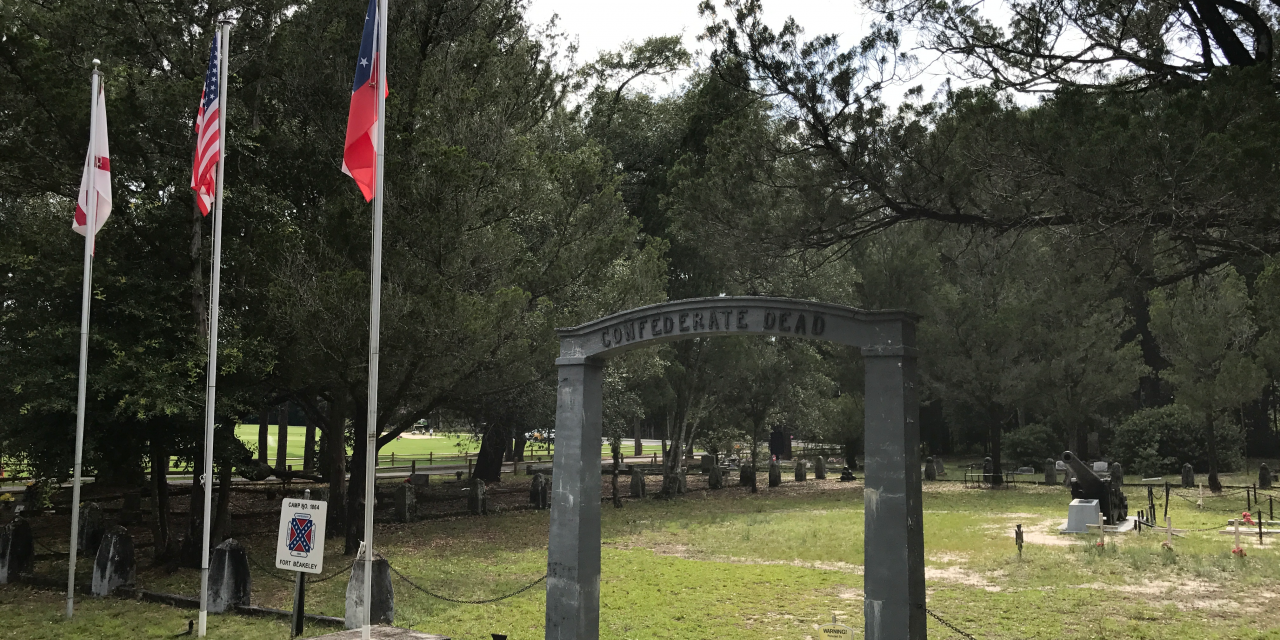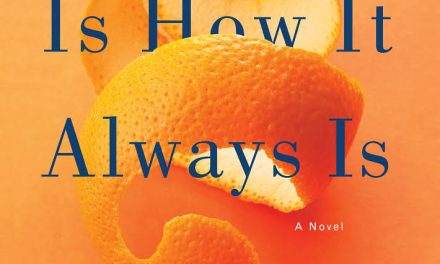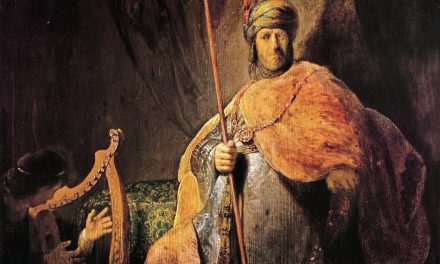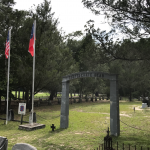
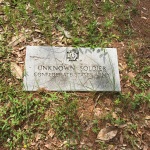 In June I had the opportunity to visit a confederate cemetery in Point Clear, Alabama. I was there to honor Lillie A. Smith (1875-1947), a woman who meant a great deal to my extended family. But since her grave is very close to the confederate cemetery, we also toured that portion of the property.
In June I had the opportunity to visit a confederate cemetery in Point Clear, Alabama. I was there to honor Lillie A. Smith (1875-1947), a woman who meant a great deal to my extended family. But since her grave is very close to the confederate cemetery, we also toured that portion of the property.
I had mixed feelings on our visit. On the one hand, it is a beautiful property with old oak trees, magnolia trees with Spanish moss, and exudes a peaceful atmosphere for remembering the dead and considering one’s own eventual death. On the other hand, I felt uneasy about the symbolism of the cemetery and comments on travel message boards and websites that promote a particular view of history. The Sons of Confederate Veterans, who maintain the cemetery explain their agenda:
The citizen-soldiers who fought for the Confederacy personified the best qualities of America. The preservation of liberty and freedom was the motivating factor in the South’s decision to fight the Second American Revolution. The tenacity with which Confederate soldiers fought underscored their belief in the rights guaranteed by the Constitution. These attributes are the underpinning of our democratic society and represent the foundation on which this nation was built.
But this revisionist history fails to recognize the suffering caused by chattel slavery and the pervasive inequalities (even among whites) in the South before the Civil War. It might make a descendent of a civil war veteran feel good to say that your ancestor “personified the best qualities of America.” But is it true? What does that mean? This is not the forum to answer the complex question of why the Civil War was fought, but holding up these soldiers as heroes without any attention to the legacy of slavery in the deep South should make any Christian uneasy. While surely some soldiers in the Confederate army had virtues for which they should be remembered positively, a humble and honest re-telling of our nation’s history should be as truthful as possible.
Donald Trump Doesn’t Get It
In his press conference today, President Trump made it clear that he doesn’t understand this, but previous presidents have been more helpful. President George W. Bush said at the dedication ceremony for the National Museum of African American History & Culture,
“A great nation does not hide its story. It faces its flaws and corrects them.”
While today, Trump said, after confirming that he had time to “know all of the facts,” that the Unite the Right protesters were not all white supremacists. They had the correct permit to protest, and they just wanted to protest the taking down of a statue of Robert E. Lee. He went on to say that there is blame “on both sides” for the violence that occurred in Charlottesville, saying that there were “very fine people” on both sides.
“Well, I do think there’s blame — yes, I think there’s blame on both sides. You look at — you look at both sides. I think there’s blame on both sides. And I have no doubt about it, and you don’t have any doubt about it either. … But you also had people that were very fine people, on both sides. … You had people in that group that were there to protest the taking down of, to them, a very, very important statue and the renaming of a park from Robert E. Lee to another name.”“So this week it’s Robert E. Lee. I noticed that Stonewall Jackson’s coming down. I wonder, is it George Washington next week? And is it Thomas Jefferson the week after? You know, you all — you really do have to ask yourself, where does it stop?”
“Are we going to take down the statue (of Jefferson)? Because he was a major slave owner. Now, are we going to take down his statue? So you know what? It’s fine. You’re changing history. You’re changing culture. And you had people, and I’m not talking about the neo-Nazis and the white nationalists, because they should be condemned totally. But you had many people in that group other than neo-Nazis and white nationalists.”
Posed as genuine questions, these can be fruitful for deliberation. What were the real motivations of the protesters? Why did so many seem so angry? Where does it stop? How far should we reach into the history of the United States of America to understand the legacies of brutal torture, rape, slavery, disenfranchisement, colonialism, and hate that are a part of our history? What is the appropriate response to such uncovering of structural sin? But I don’t think that’s the kind of critical thinking that the President really intended to provoke. Instead, he takes up the project of white-washing history as history, claiming that those who find the legacy of Lee problematic are the ones who are “changing history.” He says he took time to understand the facts, but does not weigh in on the “Blood and Soil” chants and neo-Nazi salutes that these “fine people” were performing in Charlottesville. Not only is this a selective reading of history retold to advantage whites, but it is a selective retelling of the Charlottesville protests and the violence that ensued there.
Donald Trump Doesn’t Get It, But Mitch Landrieu Does
Maybe we should forgive the President’s lack of historical acumen and ignorance about the “facts” of the groups who planned the Charlottesville protests. After all, he’s not from the South. But are there any politicians in the Deep South who can point us in a better direction? Thankfully, yes. Mitch Landrieu’s speech on the removal of confederate monuments in New Orleans should have been required reading for President Trump before today’s presser. It is an eloquent, sobering look at the real history of New Orleans and an ethical stand against white-washing that history to empower the elite. Rather, Mayor Landrieu celebrates the diversity of New Orleans while also being willing to take a hard look at its history.
You see– New Orleans is truly a city of many nations, a melting pot, a bubbling caldron of many cultures. There is no other place quite like it in the world that so eloquently exemplifies the uniquely American motto: e pluribus unum– out of many we are one. But there are also other truths about our city that we must confront. New Orleans was America’s largest slave market: a port where hundreds of thousands of souls were bought, sold and shipped up the Mississippi River to lives of forced labor of misery of rape, of torture. America was the place where nearly 4000 of our fellow citizens were lynched, 540 alone in Louisiana; where the courts enshrined ‘separate but equal’; where Freedom Riders coming to New Orleans were beaten to a bloody pulp. So when people say to me that the monuments in quest are history, well what I just described is real history as well, and it is the searing truth.
He goes on…
And it immediately begs the questions, why there are no slave ship monuments, no prominent markers on public land to remember the lynchings or the slave blocks; nothing to remember this long chapter of our lives; the pain, the sacrifice, the shame… all of it happening on the soil of New Orleans. So for those self-appointed defenders of history and the monuments, they are eerily silent on what amounts to this historical malfeasance, a lie by omission. There is a difference between remembrance of history and reverence of it.
Landrieu explains that the city of New Orleans chose to remove the four monuments to the Lost Cause of the Confederacy because the monuments were not erected just to honor those men, but as part of a movement that was known as the The Cult of the Lost Cause.
This ‘cult’ had one goal–through monuments and through other means- to rewrite history to hide the truth, which is that the Confederacy was on the wrong side of humanity…. These monuments purposefully celebrate a fictional, sanitized Confederacy; ignoring the death, ignoring the enslavement, and the terror that it actually stood for.
Landrieu confesses that it took him time to arrive at his conviction that removing the monuments was the right thing to do. He thanks his friends who posed challenging questions to him over the years, questions like:
Consider these four monuments from the perspective of an African American mother or father trying to explain to their fifth grade daughter who Robert E. Lee is and why he stands atop our beautiful city. Can you do it? Can you look into that young girl’s eyes and convince her that Robert E. Lee is there to encourage her? Do you think she will feel inspired and hopeful by that story? Do these monuments help her see a future with limitless potential? Have you ever thought that if her potential is limited, yours and mine are too?
This speech encouraging empathy, putting oneself in the shoes of the young black girl and seeing reality from her perspective, is miles apart from Trump’s defensive reaction today. Instead, Landrieu reminds us of the truth of our interconnectedness: when her potential is limited, so is mine and so is yours. We are in this thing together. We must work together, all of us, to uncover our shameful history and to build a better future for our children. Symbols and monuments have a place in city squares and on college campuses. But we should be careful about the messages they send, as Landrieu reminds us.
We have not erased history; we are becoming part of the city’s history by righting the wrong image these monuments represent and crafting a better, more complete future for our children and for future generations. And unlike when these Confederate monuments were first erected as symbols of white supremacy, we now have a chance to create not only new symbols, but to do it together, as one people.
The Wisdom of Christian Ethicists in This Time of Remembering and Looking Forward
Trump and Landrieu speak as politicians, but what do Christian leaders have to say? On Sunday I quoted the public statement by Cardinal DiNardo and Bishop Dewane. A group of Christian ethicists issued a statement today “On White Supremacy and Racism” in light of the weekend’s events in Charlottesville that further illustrates what a Christian approach to this problem looks like. The jointly written statement draws on themes of discipleship, human dignity, and sin, as these selections demonstrate:
As followers of Jesus Christ and as Christian ethicists representing a range of denominations and schools of thought, we stand in resolute agreement in firmly condemning racist, anti-Semitic, and anti-Muslim, neo-Nazi ideology as a sin against God that divides the human family created in God’s image.
The greatest commandments, as Jesus taught and exemplified, are to love God and to love our neighbor as ourselves; and so as children of God, and sisters and brothers to all, we hold the following:
-
We reject racism and anti-Semitism, which are radical evils that Christianity must actively resist.
-
We reject the sinful white supremacy at the heart of the “Alt Right” movement as Christian heresy.
-
We reject the idolatrous notion of a national god. God cannot be reduced to “America’s god.”
-
We reject the “America First” doctrine, which is a pernicious and idolatrous error. It foolishly asks Americans to replace the worship of God with the worship of the nation, poisons both our religious traditions and virtuous American patriotism, and isolates this country from the community of nations. Such nationalism erodes our civic and religious life, and fuels xenophobic and racist attacks against immigrants and religious minorities, including our Jewish and Muslim neighbors.
-
We confess that all human beings possess God-given dignity and are members of one human family, regardless of race, ethnicity, religion, or country of origin.
-
We proclaim that the gospel of Jesus Christ has social and political implications. Those who claim salvation in Jesus Christ, therefore, must publicly name evil, actively resist it, and demonstrate a world of harmony and justice in the midst of racial, religious and indeed all forms of human diversity.
The statement encourages Christians to participate in peaceful protests and not to remain passive bystanders; and signatories commit to “the ongoing, hard work of building bridges and restoring wholeness where racist and xenophobic ideologies have brought brokenness and pain.” I am grateful to those who crafted the statement, and signed it enthusiastically, but I know very well that this commitment to condemn white supremacy, build bridges of understanding, and restore wholeness in American culture is a complex, even life-long task for Christians in the U.S.
White Americans need to take a hard look at our history and come to terms with our obligations to renounce unearned privileges. We need to retell the hard, cruel stories of the past not to demonize whites but to better understand the legacies of systems of oppression on which our country was formed. This is the hard work of education, of consciousness-raising, of conscience-formation. The church has an essential role to play for Christians, and many pastors this weekend took up the challenge of speaking out about the sin of racism and the importance of social justice and solidarity. We can’t avoid these issues in our classrooms or in our churches. That doesn’t mean we all feel comfortable addressing racism or challenging the moral blindness of fellow Christians. But speaking the truth in love is a good starting point.

